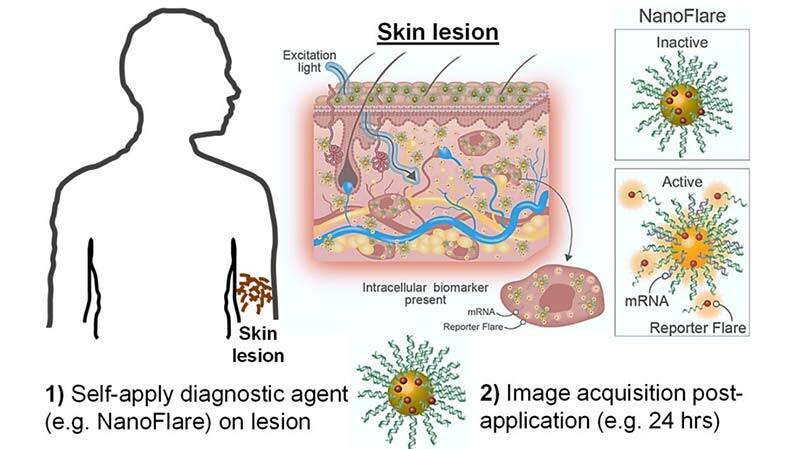Topical Nanotechnology Diagnoses Skin Disease
Simplifying Skin Disease Diagnosis with Topical Nanotechnology
SLAS News on Topical Nanotechnology (May 18, 2018) — In a new SLAS Technology auto-commentary, two authors of an article recently published in Nature Biomedical Engineering (“Abnormal Scar Identification with Spherical Nucleic Acid Technology” – www.nature.com/articles/s41551-018-0218-x) share more insight into their unique method for skin disease diagnosis using NanoFlare nanotechnology. In particular, the authors address point-of-care diagnosis and image acquisition, which are the primary bottlenecks in efficient disease diagnosis.
New Topical Nanotechnology simplifies the the diagnosis of skin diseases
 Authors David Yeo, Ph.D., and Prof. Chenjie Xu, Ph.D., of the School of Chemical and Biomedical Engineering at Nanyang Technological University (Singapore) use NanoFlare to enable biopsy-free disease diagnosis and progression monitoring in response to therapy. It is a minimally-invasive, self-applied alternative that can reduce scarring and infection risks; improve accessibility to disease diagnosis; provide timely feedback of treatment efficacy; and reduce healthcare personnel time and attention, hence the overall healthcare burden.
Authors David Yeo, Ph.D., and Prof. Chenjie Xu, Ph.D., of the School of Chemical and Biomedical Engineering at Nanyang Technological University (Singapore) use NanoFlare to enable biopsy-free disease diagnosis and progression monitoring in response to therapy. It is a minimally-invasive, self-applied alternative that can reduce scarring and infection risks; improve accessibility to disease diagnosis; provide timely feedback of treatment efficacy; and reduce healthcare personnel time and attention, hence the overall healthcare burden.
Topical Nanotechnology a unique new approach
This vision of simplifying disease diagnosis using topically-applied nanotechnology could change the way skin diseases such as abnormal scars are diagnosed and managed.
Simplifying Skin Disease Diagnosis with Topical Nanotechnology can be accessed for free for a limited time at http://journals.sagepub.com/doi/full/10.1177/2472630318775314. For more information about SLAS and its journals, visit www.slas.org/journals.
Simplifying Skin Disease Diagnosis with Topical Nanotechnology
Simplifying Skin Disease Diagnosis with Topical Nanotechnology
David C. Yeo and Chenjie Xu
Abstract
A new study published in the journal Nature Biomedical Engineering1 documents a novel diagnostic technology that exploits topically applied nanotechnology to detect skin tissue biomarkers for diagnosis. This concept is demonstrated by noninvasively imaging connective tissue growth factor (CTGF) mRNA in abnormal scar cells, whole tissue, and animal models.
In this commentary, we highlight the main findings and discuss their implications. Successful implementation in the clinic could give rise to self-applied, biopsy-free diagnostic technology and significantly reduce healthcare burden. Crucially, noninvasive visualization of disease biomarkers, mobile device signal acquisition, and Internet-enabled transmission could significantly transform the diagnosis of skin disease and other superficial tissues.

1. NanoFlares for biopsy-free self-diagnosis. Skin lesions are noninvasively diagnosed by the self-application of suitable
diagnostic agents (e.g., NanoFlares). NanoFlares are topically applied on the lesion, which penetrate the skin barrier, interacting with intracellular mRNA biomarkers. In the presence of the target gene (e.g., disease biomarker or other control genes), mRNA interacts with the NanoFlare, dislodging (releasing) the reporter flare. Leaving the proximity of the gold nanoparticle core, a strong fluorescence is generated. Without target gene hybridization, fluorescence signal does not appreciably increase but remains below background levels. In the presence of sufficient disease biomarker, fluorescence signal can be superficially acquired. Portions of this image were originally published in Nature Biomedical Engineering.
References:
- Yeo, D. C.; Wiraja, C.; Paller, A. S.; et al. Abnormal Scar Identification with Spherical Nucleic Acid Technology. Nat. Biomed. Eng. 2018. DOI: 10.1038/s41551-018-0218-x.
- SLAS TECHNOLOGY: Translating Life Sciences Innovation
Abnormal scar identification with spherical-nucleic-acid technology
The accurate diagnosis of scar type and severity relies on histopathology of biopsied tissue, which is invasive and time-consuming, causes discomfort and may exacerbate scarring. Here, we show that imaging nanoprobes for the live-cell detection of intracellular messenger RNA (mRNA) (also known as NanoFlares) enable measurements of the expression of connective tissue growth factor (CTGF) as a visual indicator of hypertrophic scars and keloids. Learn more
SLAS
Simplifying Skin Disease Diagnosis with Topical Nanotechnology
SLAS News (May 18, 2018)
About SLAS
SLAS is a global community of more than 30,000 scientists—from academia, government and industry—collectively focused on leveraging the power of technology to achieve scientific objectives. We consider a primary part of our mission to unite great minds in science and technology for the advancement of all research.
